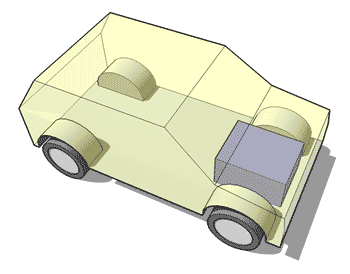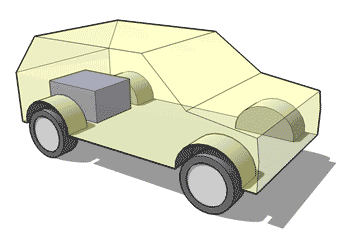Engine & driveline
The following points are the most crucial factors to take into account when considering the engine and drive-line layouts of a car for the track.
The moment of inertia (flywheel effect)
The moment of inertia is a physics term which describes how difficult it is to turn an object. Think about a hammer with the head at one end versus the head in the middle. The one with the head in the middle will be much easier to rotate around the central point as most of the weight is concentrated there.
The moment of inertia in a car varies depending on whether the heavier components are located close to the centre or towards the extremities. The more spread out from the centre, the more difficult it is to rapidly change the direction the car is travelling. Mid engine cars thus have the greatest natural agility.
Weight distribution
Many sports car manufacturers strive for a 50:50 weight distribution, and this is another important factor which contributes to the natural handling ability of the car. The closer you get to a 50:50 weight distribution, the more balanced the car becomes due to more equal weight begin divided between each of the four wheels. The weight acting on any tyre affects the level of grip it can provide, and cars with one axle providing more grip than the other can lead to handling issues on the limit.
The division of grip demands for drive and steering
A tyre can only provide a finite amount of grip and if you’re using it all up by accelerating hard, there will be none left for cornering. The front wheels exert most of the cornering effort and in a front wheel drive car they also have to accelerate and provide most of the braking. The ideal scenario is to provide the drive via the rear axle, and allow the front wheels to concentrate on steering.
Click here for more information on tyres and grip
Front engine cars
Front engine, front wheel drive
- Most commonly available, easy to find and cheap
- May need some tweaks to handle well on the track
Front engine, rear wheel drive
- Good weight distribution
- Can be prone to oversteer
If you’re buying a road car to convert to a racing machine, chances are you’ll end up with the engine in the front. The majority of cars on the road are front wheel drive due to the convenient packaging which means they’re generally cheaper than alternatives.
The front engine, rear wheel drive combination provides good weight distribution, but has a higher moment of inertia than mid engine varieties. In general, this layout has most of the advantages of much more specialist cars with very few drawbacks so can be a very good choice for a track car.
The disadvantage of the front engine, front wheel drive layout is that the driven wheels have the additional demands of steering. This means if you’re accelerating hard, less grip is available for cornering and this can result in understeer. The lighter rear end can also have a tendency to ‘come round’ if you lift off the throttle mid-corner, as the forward weight transfer reduces the grip at the back to very low levels.
Mid engine (rear of four wheel drive)
- Low ‘moment of inertia’
- Easy to achieve 50:50 weight distribution
If the engine is mounted between the rear axle and the driver, you’re in a mid engine car.
The main advantage of mid engine cars is that they have a low ‘moment of inertia’. This means when cornering it is easier to turn the car to a new direction, thus increasing the manoeuvrability and stability. In addition, less rotational momentum is generated, which can lead to oversteer.
Most sports car manufacturers aim for a 50:50 weight distribution to provide neutral handling characteristics, and with mid engine cars it is much easier to achieve this. Even though some front engine rear wheel drive cars may have a 50:50 weight distribution, they will have a higher ‘moment of inertia’ due to the majority of the weight being at the extremities. Think of twisting a hammer with a head at one end versus a head in the middle.
An additional benefit of the mid engine layout is that the mass of the engine is more equally split between all four wheels which leads to naturally neutral handling characteristics.
Rear engine (rear or four wheel drive)
- High moment of inertia – it wants to keep turning even when steering has stopped and resists changes to rotation
- High available grip off the line and under acceleration.
On paper, a rear engine car is a potentially unstable design. The heavy end generates much more momentum than the light front end and is more difficult to slow down and change direction. Think of an arrow flying in reverse!
Rear engine cars can be prone to oversteer when lifting off the throttle or braking during a corner. Even when braking with locked wheels in a straight line you can find the back of the vehicle has a tendency to come round. Rear engine cars must be treated with respect – when oversteer is invoked it can be very difficult to control.
Having said that, some of the best track cars of all time have been produced by Porsche and clever car setup and tuning can allow rear wheel drive to produce astonishing results. The front wheels are free to use all available grip for steering, and the weight transfers under acceleration provide plenty of traction at the back.
Comparison of the natural characteristics of various drive and engine layouts
Key:
FWD = Front wheel drive
RWD = Rear wheel drive
4WD = Four wheel drive
Note that although a car may have relatively poor natural attributes, these can usually be addressed through vehicle setup and tuning. For example, the rear wheel setup of a Porsche 911 is not a naturally stable design but years of clever tuning has created a superb overall car. There are many excellent front wheel drive cars!
| Moment of inertia | Weight distribution | Division of steering & drive | Off the line grip | Overall traction | Handling | Total score | |
| Front engine FWD | ● | ● | ● | ●● | ●●● | ●● | 9 |
| Front engine RWD | ●● | ●●●● | ●●● | ●● | ●●● | ●●● | 17 |
| Front engine 4WD | ●● | ●●● | ●● | ●●●● | ●●●● | ●●● | 18 |
| Rear engine RWD | ● | ● | ●●● | ●●● | ●●● | ●● | 12 |
| Rear engine 4WD | ● | ●● | ●● | ●●●● | ●●●● | ●●● | 16 |
| Mid engine RWD | ●●●● | ●●●● | ●●● | ●●● | ●●●● | ●●●● | 22 |
| Mid engine 4WD | ●●● | ●●●● | ●● | ●●●● | ●●●● | ●●●● | 21 |





Leave a Reply